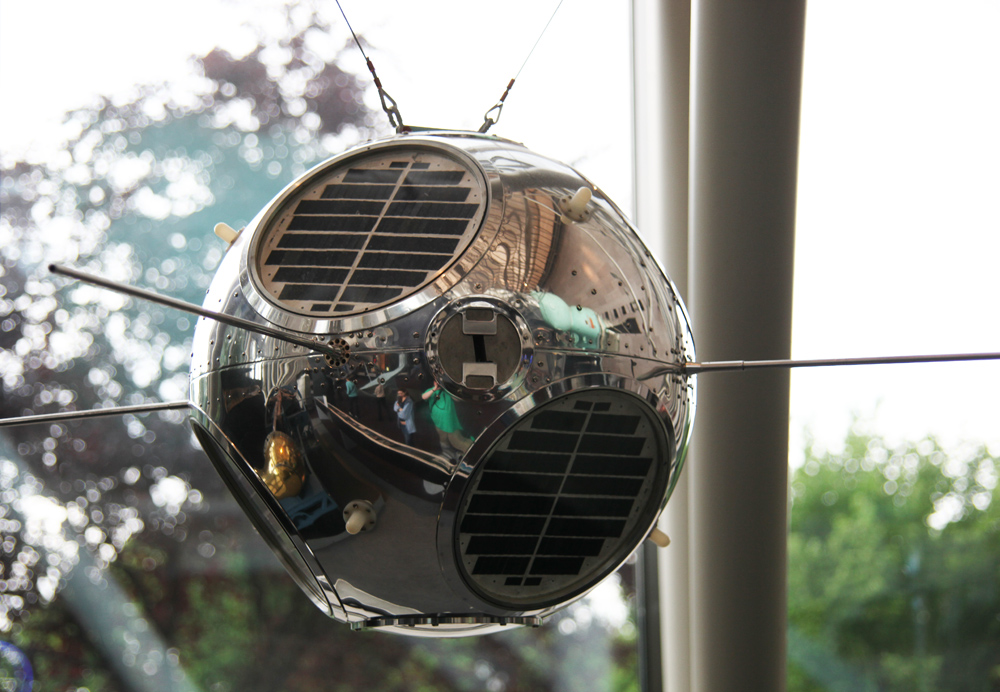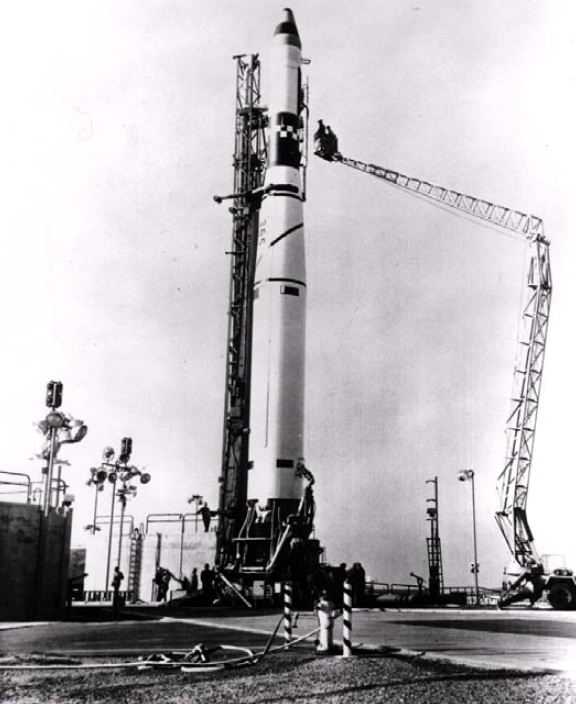|
SOLRAD
SOLRAD (short for "SOLar RADiation," sometimes presented as "SOLRAD") was an American series of satellites sponsored by the US Navy in a program to continuously monitor the Sun. SOLRAD was the Naval Research Laboratory's first post-Vanguard satellite. Background Until the Kennedy administration, American satellite launches were unclassified. As a result, the United States Air Force and the Navy found themselves in the awkward position of wanting to orbit spy satellites but not reveal their nature to potential enemies. Just as the Air Force elected to pair their capsule film recovery satellites with biological payloads under the Discoverer program, so did the Navy develop a scientific cover for its GRAB series of radio/radar surveillance (ELINT) satellites. The field of solar X-ray astronomy lent itself well to such an application. As the Earth's atmosphere absorbs extraterrestrial X-ray sources (of which the Sun is by far the most prominent), it is necessary to send senso ... [...More Info...] [...Related Items...] OR: [Wikipedia] [Google] [Baidu] |
SOLRAD 1
SOLRAD (SOLar RADiation) 1 is the public designation for SOLRAD/GRAB 1, a combination science and surveillance satellite launched into orbit on 22 June 1960. It was the first satellite to successfully observe solar X-rays, the first to conduct surveillance from orbit, and the first to be launched with another instrumented satellite (the unrelated navigation satellite, Transit 2A). Developed by the United States Navy's Naval Research Laboratory (NRL), the satellite was in many ways a direct successor to NRL's Project Vanguard, the first American satellite program. The satellite's scientific mission was a success, sending useful data until November 1960 that determined normal solar X-ray output and confirmed the connection between increased solar X-ray activity and radio fade-outs. The SOLRAD scientific package aboard the satellite provided cover for the Galactic Radiation and Background (GRAB) electronic surveillance package, whose mission was to map the Soviet Union's air defe ... [...More Info...] [...Related Items...] OR: [Wikipedia] [Google] [Baidu] |
SOLRAD 3
SOLRAD (SOLar RADiation) 3 was a solar X-ray satellite, the third in the SOLRAD program. Developed by the United States Navy's Naval Research Laboratory (USNRL), it shared satellite space with and provided cover for the Navy's GRAB 2 (Galactic Radiation And Background), a secret electronic surveillance program. The satellite was launched atop a Thor-Ablestar rocket on 29 June 1961 along with Transit 4A and the University of Iowa's Van Allen Belts Injun 1 satellite. After reaching orbit, SOLRAD 3/GRAB 2 and INJUN 1 separated from Transit 4A but not from each other. Though this reduced SOLRAD 3's data-transmission ability by half, the satellite still returned valuable information regarding the Sun's normal levels of X-ray emissions. The SOLRAD experiment package also established that, during solar flares, the higher the energy of emitted X-rays, the more disruption caused on the Earth's thermosphere (and radio transmissions therein). The GRAB mission was also highly successf ... [...More Info...] [...Related Items...] OR: [Wikipedia] [Google] [Baidu] |
SOLRAD 2
SOLRAD (SOLar RADiation) 2 was the public designation for a combination surveillance and solar X-rays and ultraviolet scientific satellite, the second in the SOLRAD program developed by the United States Navy's Naval Research Laboratory. The SOLRAD scientific package aboard the satellite provided cover for the GRAB (Galactic Radiation and Background) electronic surveillance package, the mission of which was to map the Soviet Union's air defense radar network. SOLRAD 2 was launched along with Transit 3A atop a Thor-Ablestar rocket on 30 November 1960, but both satellites failed to reach orbit when the booster flew off course and was destroyed, raining debris over Cuba, which prompted official protests from the Cuban government. As a result, future SOLRAD flights were programmed to avoid a Cuban flyover during launch. Background In 1957, the Soviet Union began deploying the S-75 Dvina surface-to-air missile, controlled by Fan Song fire control radars. This development made ... [...More Info...] [...Related Items...] OR: [Wikipedia] [Google] [Baidu] |
SOLRAD 4B
SOLRAD (SOLar RADiation) 4B was a solar X-ray, ultraviolet, and electronic surveillance satellite. Developed by the United States Navy's United States Naval Research Laboratory, it was the fifth in both the SOLRAD and the GRAB (Galactic Radiation And Background) programs. This satellite was the only SOLRAD to be launched from Vandenberg Air Force Base, to be launched via Scout rocket, and to be launched unaccompanied by any other satellites. Launched on 26 April 1962, a fourth stage failure resulted in payload impact at 225 nautical miles of the downrange. SOLRAD 4B was the last of the SOLRAD/GRAB missions, future SOLRADs being launched with the National Reconnaissance Office's (NRO) next-generation POPPY satellites. Background The United States Navy's Naval Research Laboratory (NRL) established itself as a player early in the Space Race with the development and management of Project Vanguard (1956–1959), America's first satellite program. After Vanguard, the Navy's ne ... [...More Info...] [...Related Items...] OR: [Wikipedia] [Google] [Baidu] |
SOLRAD 4
SOLRAD (SOLar RADiation) 4 was a X-ray_astronomy#Stellar_X-ray_astronomy, solar X-rays, ultraviolet, and electronic surveillance satellite. Developed by the United States Navy's United States Naval Research Laboratory (USNRL), it was the fourth in both the SOLRAD and the Galactic Radiation and Background, GRAB (Galactic Radiation and Background) programs. The satellite was to be orbited along with Ionosphere, ionospheric study satellite LOFTI-1, LOFTI-2, the United States Army's range calibration satellite SECOR, Navy surveillance calibration satellite Surcal, and the University of Iowa's Van Allen radiation belt, Van Allen radiation belts-studying Injun (satellite), Injun 2 satellite. This unprecedented five-in-one mission, called "Composite 1" and "Buckshot", ended in failure on 24 January 1962 after its Thor-Ablestar's second stage failed to deliver the payloads to orbit. Background The United States Navy's United States Naval Research Laboratory (USNRL) established its ... [...More Info...] [...Related Items...] OR: [Wikipedia] [Google] [Baidu] |
SOLRAD 7B
SOLRAD 7B was the eighth solar X-Ray monitoring satellite in the SOLRAD series and the fifth to successfully orbit the Earth. It was launched via Thor Augmented Delta-Agena D along with seven other satellites on March 9, 1965. The satellite provided continuous coverage of the Sun during the International Quiet Solar Year from March through October 1965. History The SOLRAD science satellite program was conceived in 1958 to observe the Sun in the X-ray spectrum. It was quickly combined, to provide civilian cover (launches being unclassified at that time), with the concurrently conceived United States Naval Research Laboratory's GRAB satellite project, which would collect information on foreign radars and communications installations. There were five SOLRAD/GRAB missions between 1960 and 1962, with the scientific SOLRAD experiments sharing satellite space with GRAB's intelligence payload. Two of the missions were successful. In 1962, all U.S. overhead reconnaissance projects wer ... [...More Info...] [...Related Items...] OR: [Wikipedia] [Google] [Baidu] |
SOLRAD 7A
SOLRAD 7A was the seventh solar X-Ray monitoring satellite in the SOLRAD SOLRAD (short for "SOLar RADiation," sometimes presented as "SOLRAD") was an American series of satellites sponsored by the US Navy in a program to continuously monitor the Sun. SOLRAD was the Naval Research Laboratory's first post-Vanguard satell ... series, and the fourth to successfully orbit the Earth. It was boosted into orbit along with four other military satellites atop a Thor-Agena, Thor Augmented Delta-Agena D rocket on January 11, 1964. Data returned by SOLRAD 7A dramatically revised scientific models of the solar corona. History The SOLRAD science satellite program was conceived in 1958 to observe the Sun in the X-ray spectrum. It was quickly combined, to provide civilian cover (launches being unclassified at that time), with the concurrently conceived United States Naval Research Laboratory's Galactic Radiation and Background, GRAB satellite project, which would collect information on foreign ... [...More Info...] [...Related Items...] OR: [Wikipedia] [Google] [Baidu] |
SOLRAD 6
SOLRAD (SOLar RADiation) 6 (also called SOLRAD 6A) was the sixth solar X-ray monitoring satellite in the United States Navy's SOLRAD series, the third in the series to successfully orbit. It was launched along with POPPY 2, an ELINT surveillance package, as well as three other satellites, boosted into orbit via a Thor Augmented Delta-Agena D rocket on June 15, 1963. Background The SOLRAD science satellite program was conceived in 1958 to observe the Sun in the X-ray spectrum. It was quickly combined, to provide civilian cover (launches being unclassified at that time), with the concurrently conceived United States Naval Research Laboratory's GRAB satellite project, which would collect information on foreign radars and communications installations. There were five SOLRAD/GRAB missions between 1960 and 1962, with the scientific SOLRAD experiments sharing satellite space with GRAB's intelligence payload. Two of the missions were successful. In 1962, all U.S. overhead reconnais ... [...More Info...] [...Related Items...] OR: [Wikipedia] [Google] [Baidu] |
Galactic Radiation And Background
Galactic Radiation and Background (GRAB) was the first successful United States orbital surveillance program, comprising a series of five Naval Research Laboratory electronic surveillance and solar astronomy satellites, launched from 1960 to 1962. Though only two of the five satellites made it into orbit, they returned a wealth of information on Soviet air defense radar capabilities as well as useful astronomical observations of the Sun. Development In 1957, the Soviet Union began deploying the S-75 Dvina surface-to-air missile, controlled by Fan Song fire control radars. This development made penetration of Soviet air space by American bombers more dangerous. The United States Air Force began a program of cataloging the rough location and individual operating frequencies of these radars, using electronic reconnaissance aircraft flying off the borders of the Soviet Union. This program provided information on radars on the periphery of the Soviet Union, but informati ... [...More Info...] [...Related Items...] OR: [Wikipedia] [Google] [Baidu] |
GRAB-3b
Galactic Radiation and Background (GRAB) was the first successful United States orbital surveillance program, comprising a series of five Naval Research Laboratory electronic surveillance and solar astronomy satellites, launched from 1960 to 1962. Though only two of the five satellites made it into orbit, they returned a wealth of information on Soviet air defense radar capabilities as well as useful astronomical observations of the Sun. Development In 1957, the Soviet Union began deploying the S-75 Dvina surface-to-air missile, controlled by Fan Song fire control radars. This development made penetration of Soviet air space by American bombers more dangerous. The United States Air Force began a program of cataloging the rough location and individual operating frequencies of these radars, using electronic reconnaissance aircraft flying off the borders of the Soviet Union. This program provided information on radars on the periphery of the Soviet Union, but information on ... [...More Info...] [...Related Items...] OR: [Wikipedia] [Google] [Baidu] |
Explorer 30
The SOLRAD 8,Explorer 30 or SE-A satellite was one of the NASA SOLRAD (Solar Radiation) program that began in 1960 to provide continuous coverage of solar radiation with a set of standard photometers. SOLRAD 8 was a spin-stabilized satellite oriented with its spin axis perpendicular to the sun-satellite line so that the 14 solar X-ray and ultraviolet photometers pointing radially outward from its equatorial belt viewed the sun on each revolution. Data were transmitted in real time by means of an FM / AM the satellite's telemetry system and were recorded by the stations on the Spacecraft Tracking and Data Acquisition Network (STADAN) tracking network. Eclipse 1966 The satellite observed the solar eclipse on 20 May 1966. This observation may have been the first observation of a solar eclipse by an artificial satellite. Mission The satellite performed normally, except for the spin system, which failed to maintain 60 rpm (at spin rates below 10 rpm data reduction became diffi ... [...More Info...] [...Related Items...] OR: [Wikipedia] [Google] [Baidu] |


_(21648912280).jpg)

.png)